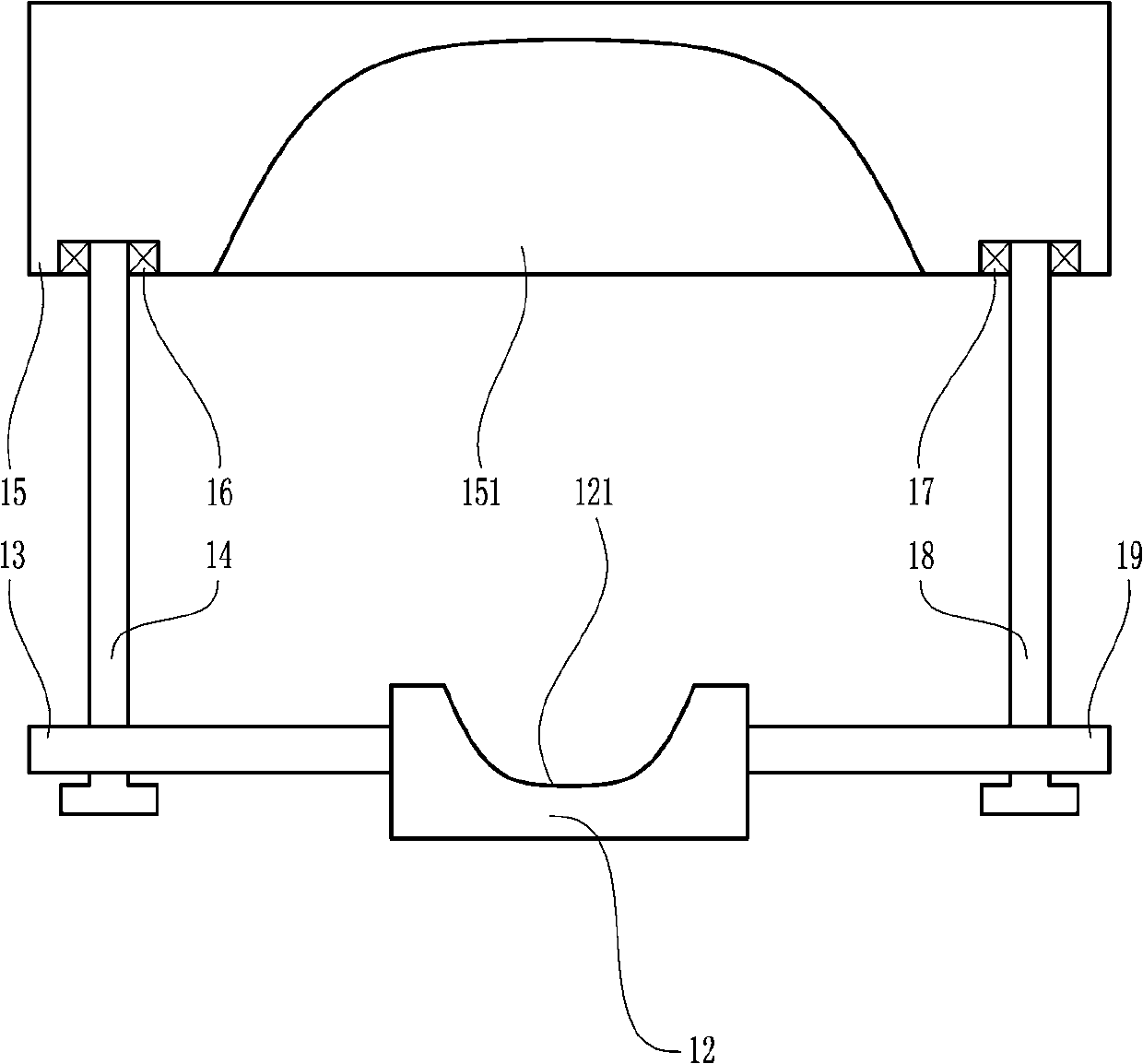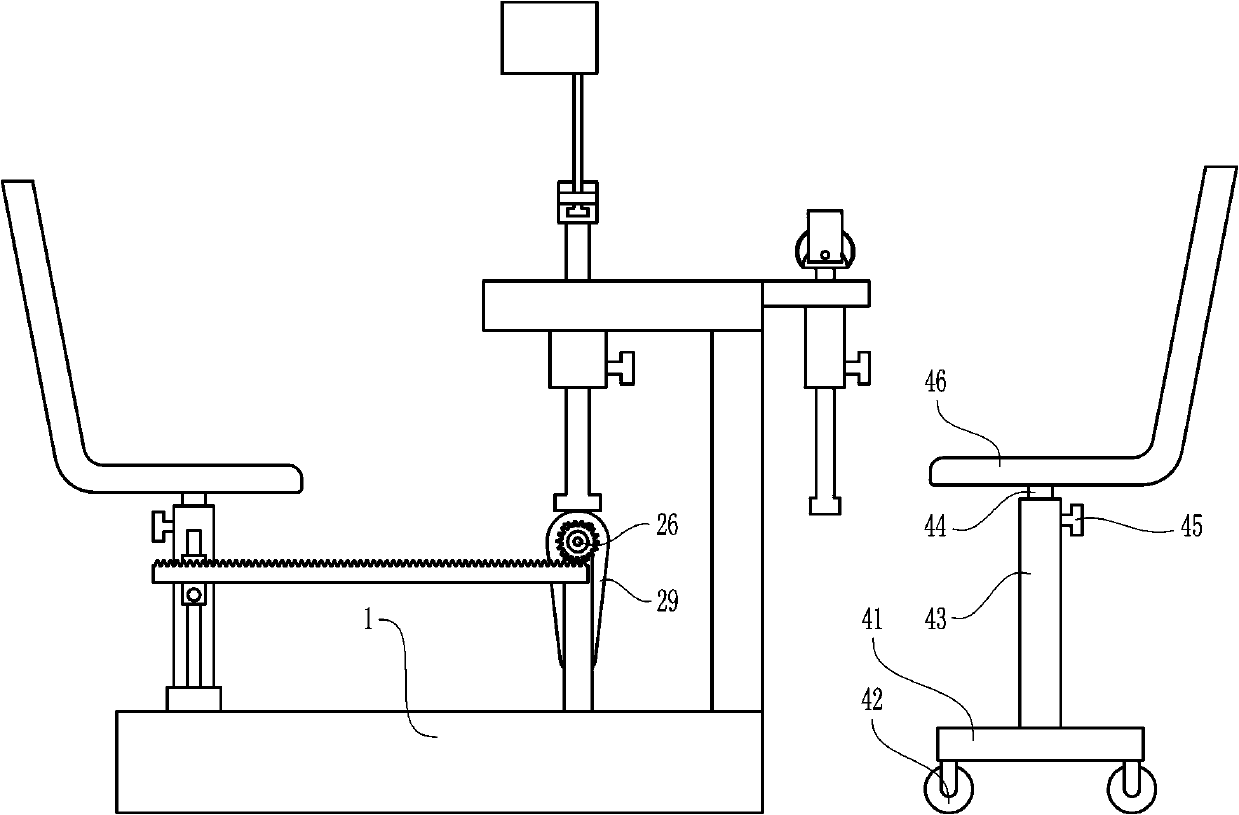An easily adjustable examination table for ophthalmology
An examination table and ophthalmology technology, applied in the field of examination tables, can solve the problems of inability to adjust, increase the burden on users, affect the patient's eye examination and treatment, etc., and achieve the effect of meeting the needs of use and facilitating the examination.
- Summary
- Abstract
- Description
- Claims
- Application Information
AI Technical Summary
Problems solved by technology
Method used
Image
Examples
Embodiment 1
[0027] An easily adjustable examination table for ophthalmology, such as Figure 1-8 As shown, it includes a base 1, a T-shaped slider 2, a first support tube 3, a first lifting rod 4, a first positioning screw 5, a first chair board 6, a support column 7, a large workbench 8, and a first guide Pipe 9, first guide rod 10, second positioning screw 11, first bracket 12, first connecting plate 13, first long screw 14, pressing block 15, first bearing 16, second bearing 17, second long Screw rod 18 and second connecting plate 19, the left side of base 1 top has first T-shaped chute 101, and T-shaped slider 2 sliding type is positioned in the first T-shaped chute 101, and the top of T-shaped slider 2 is connected There is a first support tube 3, and the first lifting rod 4 is slidingly located in the first support tube 3. The upper left side of the first support tube 3 is threaded with a first positioning screw 5, and the first positioning screw 5 is connected to the first lifting ...
Embodiment 2
[0029] An easily adjustable examination table for ophthalmology, such as Figure 1-8 As shown, it includes a base 1, a T-shaped slider 2, a first support tube 3, a first lifting rod 4, a first positioning screw 5, a first chair board 6, a support column 7, a large workbench 8, and a first guide Pipe 9, first guide rod 10, second positioning screw 11, first bracket 12, first connecting plate 13, first long screw 14, pressing block 15, first bearing 16, second bearing 17, second long Screw rod 18 and second connecting plate 19, the left side of base 1 top has first T-shaped chute 101, and T-shaped slider 2 sliding type is positioned in the first T-shaped chute 101, and the top of T-shaped slider 2 is connected There is a first support tube 3, and the first lifting rod 4 is slidingly located in the first support tube 3. The upper left side of the first support tube 3 is threaded with a first positioning screw 5, and the first positioning screw 5 is connected to the first lifting ...
Embodiment 3
[0032] An easily adjustable examination table for ophthalmology, such as Figure 1-8 As shown, it includes a base 1, a T-shaped slider 2, a first support tube 3, a first lifting rod 4, a first positioning screw 5, a first chair board 6, a support column 7, a large workbench 8, and a first guide Pipe 9, first guide rod 10, second positioning screw 11, first bracket 12, first connecting plate 13, first long screw 14, pressing block 15, first bearing 16, second bearing 17, second long Screw rod 18 and second connecting plate 19, the left side of base 1 top has first T-shaped chute 101, and T-shaped slider 2 sliding type is positioned in the first T-shaped chute 101, and the top of T-shaped slider 2 is connected There is a first support tube 3, and the first lifting rod 4 is slidingly located in the first support tube 3. The upper left side of the first support tube 3 is threaded with a first positioning screw 5, and the first positioning screw 5 is connected to the first lifting ...
PUM
 Login to View More
Login to View More Abstract
Description
Claims
Application Information
 Login to View More
Login to View More - R&D
- Intellectual Property
- Life Sciences
- Materials
- Tech Scout
- Unparalleled Data Quality
- Higher Quality Content
- 60% Fewer Hallucinations
Browse by: Latest US Patents, China's latest patents, Technical Efficacy Thesaurus, Application Domain, Technology Topic, Popular Technical Reports.
© 2025 PatSnap. All rights reserved.Legal|Privacy policy|Modern Slavery Act Transparency Statement|Sitemap|About US| Contact US: help@patsnap.com



